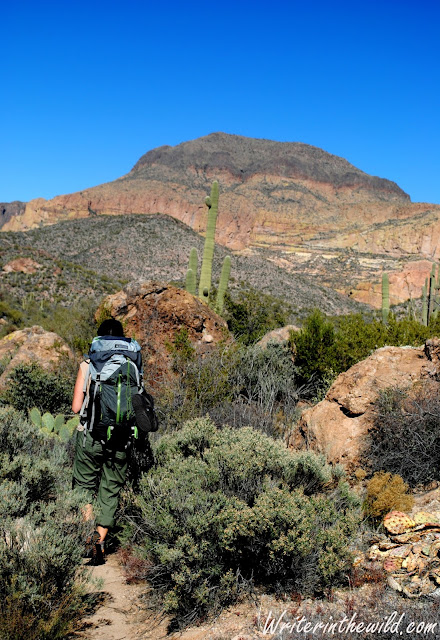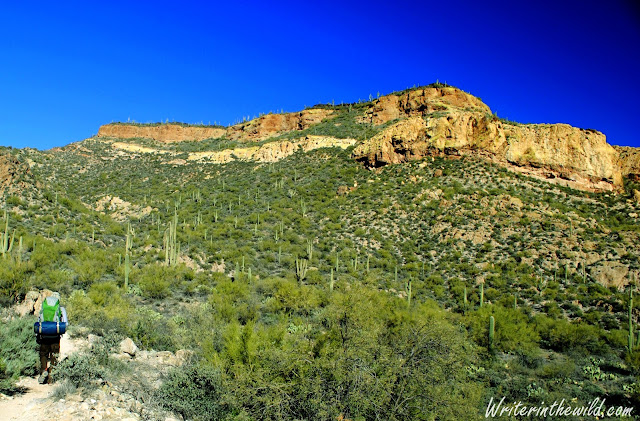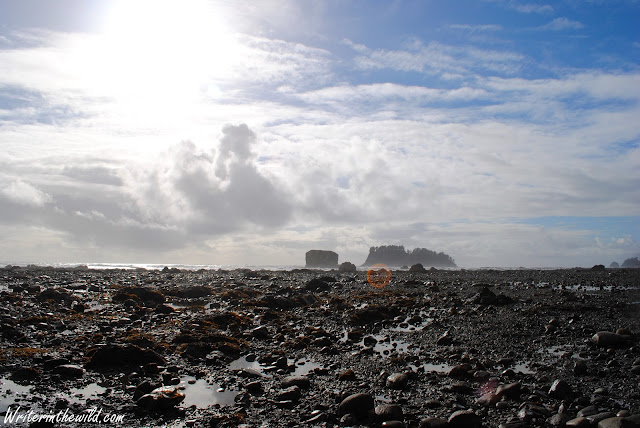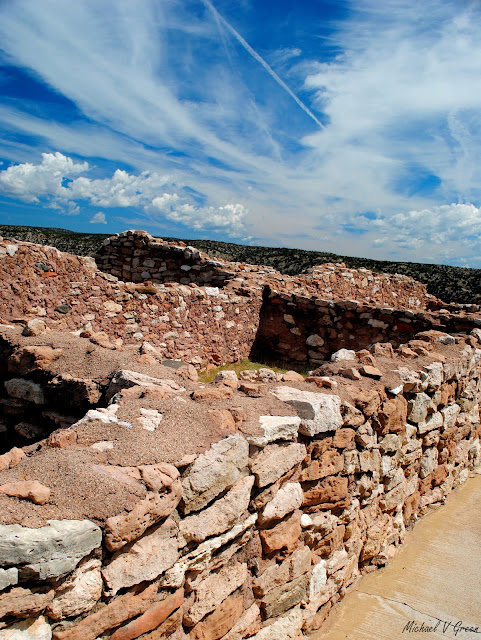 |
| Desert Backpacking |
I remember a steep climb under a relentless sun. It was miserably hot. Shade was nearly non-existent. My feet hurt from the rocks and stones that littered the trail, and my clothes were drenched in sweat from the climb and the heat. I rounded a bend, and saw a large man sitting in the middle of the trail. He was sweaty and dirty and wore a look of distress on his swollen face. One of his feet was bare, the other wore a flimsy looking black flip-flop.
"You look prepared" he said matter-of-factly as I walked up, no doubt noticing my bulging backpack and guessing (correctly) that it was full of gear.
"You have to be out here" I replied while I pondered his predicament. No pack, 1 bottle of water, and flip-flops for shoes. I recalled all the warning signs at the trailhead imploring hikers to be prepared, and wondered why this man had ignored them.
"You wouldn't happen to have any duct tape so I can fix this flip-flop do you?" he asked, obviously embarrassed.
"Actually, I do" I replied, as I took my pack off and fished out my FAST kit. I had a little roll, maybe 4 or 5 feet worth, but it was enough to fix his destroyed flip-flop. I gave him the roll. I didn't mind giving it to him. I have been carrying duct tape in my pack for 3 or 4 years, and have never had to use it for repair... But I carry it because one day it might save my ass.
It pays to be prepared in the wilderness. Even on a day hike, you should at least bring the essentials, because you never know what's going to happen. A broken flip-flop may be a poor example, because you shouldn't be hiking in flip-flops anyway, but if I hadn't come along with duct tape that guy could have found himself in a survival situation. Just last week a man and his two sons died from exposure on a day-hike after the weather turned foul. In one afternoon the sky went from blue to heavy rain, and temps dropped from the 60's to below freezing. They couldn't see in the downpour and sudden cloud cover, and lost their way. They weren't packing the essentials. Tragically they froze to death overnight.
What are these essentials you may be asking? The 10 Essentials are a list of essential systems you should always take hiking, that will increase your chances for survival if something goes wrong. Chances are many of the items comprising your 10 Essentials will never get used.
10 Essentials
1) Navigation - Map and compass, and the ability to use them properly. Even day hiking in areas near town that I know relatively well, I always bring a compass. In the backcountry, a topographic map is a must. I'm not saying you have to be an expert at orienteering to go backpacking (as I most certainly am not), but you should at least know some basics. And remember, while a GPS is a great tool, it should never be relied on for your sole means of navigation, because electronics fail, and batteries run out, and in the case of a GPS, you wont always have a signal. If your'e interested in learning orienteering (map and compass) check out your local orienteering or hiking club. Outdoor outfitters often teach classes too.
2) Sun Protection - Sun glasses, hat, sun screen. I always bring these items, but rarely use sunscreen. I never hit the trail without a hat on.
3) Insulation - An extra layer of warm clothing (fleece or a down jacket), beanie and gloves. Temps can change rapidly and unexpectedly in the wilderness, especially at higher elevations. Even in the summer when its hot, you should bring a jacket in your pack. Chances are you wont ever use it, but it could save your life if you had to stay overnight in the wilderness. Even on day hikes I always at least carry a fleece in my pack. When I go backpacking, no matter what the season, I carry a fleece (or a down vest), a beanie, thermal underwear, and a pair of gloves.
4) Illumination - Headlamp, flashlight, etc. I always carry my headlamp, even on day hikes. If for any reason you find yourself on the trail past sundown, you at least have the means to see in the dark. Your headlamp or flashlight can also be used for emergency signalling.
5) First-aid kit - My first-aid kit goes with me hiking, backpacking, and camping, and on almost every trip I dip into it at least once. You can buy pre-packaged kits from you local outdoor outfitter, but if you want to make your own, The
Washington Trails Association has a pretty comprehensive list of items. One random item I always bring that often gets overlooked is tweezers. I've used them to pull out ticks, and just last weekend saw someone on the trail using them to pull cactus spines out of their arm. Over the years I've given out band-aids, moleskin, antibiotic ointment, ibuprofen, and burn cream (to name a few) to people on the trail who either didn't bring a first-aid kit, or who didn't bring an adequately supplied kit.
6) Fire - More specifically, the means to start a fire: Lighter, waterproof matches, fire steel, etc. If you've ever watched Dual Survival, or any of the survival shows on TV, you'll know that fire starting is one of the top priorities in a survival situation. I keep a small box of waterproof matches in my FAST kit, witch always goes with me. Of course, unless you plan on smoking a joint on the top of the mountain, you probably wont use your lighter on a day hike. But remember, the 10 Essentials are designed to help you deal effectively with an emergency situation. If you find yourself stranded overnight, a fire will not only keep you warm, but can also be used for signaling, and it's a big morale booster too.
7) Repair Kit - Duct tape, safety pins, needle & thread, and cordage, to name a few. Again, the chances of you having to use these items are small, but if the need should arise, you'll be glad you have them. I carry all those items I listed. Duct tape is an important one because it fixes almost anything. Just think about what gear you are taking, and how they could fail, and plan accordingly.
8) Extra Food - Often times on day hikes, I see people carrying a bottle of water in their hand and nothing else. I always at least bring a couple granola bars or trail mix or beef jerky. Obviously, a human being can go a long time without eating, but that doesn't mean you'd want to. Eating food can be a morale booster, plus it will help keep you warm at night if you eat before bed.
9) Hydration - Nothing is worse than running out of water miles from your next source. I know because I've done it. Always bring extra water on your day hikes. If climbing the mountain is steeper than you anticipated, or the temps are higher than reported, you'll be glad you did. If you are going backpacking, then you need a way to treat the water you find in the wilderness. A filter is the most popular method. You can also treat it chemically, or with UV light. There's lots of options, so do your research.
10) Shelter - Tent, bivy sack, emergency blanket. When you're backpacking this is a given most of the time, although here in Arizona a lot of people cowboy camp, but even they should have some form of shelter just in case. I keep an emergency blanket in my FAST kit that always goes with me, even on day hikes. It might seem ridiculous to carry shelter on a day hike, but if you are caught in a storm like that poor man and his sons were, shelter from the rain could be the difference between life and death. Hypothermia kills.
If I could add anything to this list it would be this: Rain Gear. For me that means always bringing a rain jacket, even on day hikes, even in the desert. For backpacking, I bring a rain jacket and pack cover, always, no matter what. Frankly, I don't want to be wet and I don't want my gear wet. Not only is it uncomfortable, but it's dangerous. Keeping yourself and your kit dry should be a top priority in the wilderness.
Disclosure: I am by no means a survival expert. I had been thinking about writing this for some time because I frequently see people on the trail carrying practically nothing, and when I heard about that guy and his two sons dying on a day hike, it finally compelled me to sit down and write. This information is nothing new. I didn't invent the 10 Essentials. I am just passing it along in case someone doesn't know.
References:
http://news.yahoo.com/illinois-father-two-sons-freeze-death-during-hike-193245919.html
http://www.rei.com/learn/expert-advice/ten-essentials.html?gclid=CJ_m8fqL-7QCFUjZQgodSDMAIg&s_kwcid=TC|13029|10%20essentials||S|e|19595601845&ef_id=ULmYdwAAUUeBV3Nh:20130122040944:s







.JPG)





















